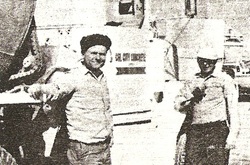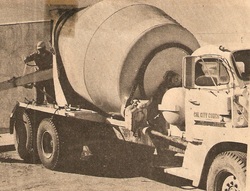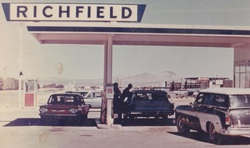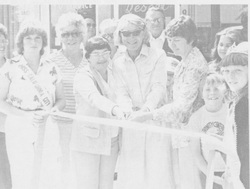Business & Industry
Cal City Concrete

In 1960, Cal City Concrete was formed by the Love Family, the first industry to come to California City and one of the oldest businesses still in existence today at 7900 Moss Avenue.
Father - Son team, Paul Love (right) and Wally Love (left), in the early 1970's, standing beside their first transit mixer purchased in 1960, a surplus G.I. truck.
Paul has since passed on and Wally has retired, but the framework of a successful company is still in place today, serving the concrete production needs of East Kern County, though under different ownership and company name.
But the story is much deeper than that, it is about struggle, sacrifice, and a work ethic unsurpassed.
It all began in 1957. Vel Graves, father of Wally Love's wife Gloria, worked as a dispatcher for a Redi-mix Company in Compton, CA. At this same company, Paul Love took his first job in the Redimix field. It was through the next 3 years, that Paul used his Engineering Mind, along with his knowledge and experience and decided to venture out, carrying forth his own dream of starting his own concrete business. That opportunity became a reality in November of 1960.
At this time, the projected rate of growth in Cal City was to be 1 house built per day. This sounded like a sure thing, but Paul needed a partner and who better to ask than his son Wally.
Wally was selling insurance in Redlands, CA, but Wally jumped at the chance to work outdoors and begin this dream with his father. Wally & his family relocated to Cal City in December of 1960. Paul handled the indoors/paperwork, and Wally handled the field-along with maintenance and repair. They couldn’t have done it without the continuous support of their wives – Evelyn & Gloria. All four had a mutual agreement, from this point on, they would give it all they had – to make this dream come true!
Paul took out a loan for $29,000, and with it he bought 2 old G.I. Redi-mix trucks, a skip loader, and a batch plant. In 1961, Cal City’s projected rate of growth did not take place as planned! In fact, not much of anything took place in Cal City for the next 5 years. It was not until 1965 that the building pace started to pick up. As a result, the business operated on a “shoe-string” for many, many years. Evelyn worked at U.S. Borax in the cafeteria while Gloria worked at R.P. Ulrich School as a teacher’s aide, helping out both families financially.
In order to survive in 1961, they had to look at other places for work. At the time, China Lake Naval Weapon Center was starting a big housing project of 1000 homes. The Company who supplied the concrete for this job needed more trucks. The Loves rented their 2 old G.I. trucks from Monday through Friday. Paul drove one and Wally drove the other. Then Friday night, the Loves would drive the trucks back to Cal City, supplying concrete on Saturday’s to their local customers. Then it was back on the road again to Ridgecrest on Monday morning.
In 1962 the demand for concrete gravitated towards U.S. Borax. This warranted the need for a second plant which was bought and placed on 5 acres in Boron on Park Knolls Blvd.
Around 1964, the company purchased 3 more old mixers, for the total truck count being 5 at this time. They latched on to a job, but its location was in Antioch, CA. This job was from May through Sept, requiring a portable plant and 2 mixer trucks. So Wally, Jay Sprague (who was an employee at the time), and their immediate families, moved to Antioch for the summer, while Paul handled U.S. Borax, and the leisure growth of Cal City. This was their first money making job to date, which allowed them to purchase another used plant., which was put in Tehachapi, for the completion of all the freeway work in the mid to late 1960s.
In 1967 Paul was elated because they were able to pay cash for their first old Transfer Truck, used to haul materials. Then in 1969, they sold the old truck and bought a brand new transfer truck which was driven for almost 20 years, by Jack Richardson.
In the late 1960's Cal City experienced a small building boom. The company relocated their upgraded plant from Tehachapi to Cal City. At the same time, other Old-Time Pioneers shared in the growth, such as John Schad of Schad Construction.
1969 was a memorable year! They replaced their used plant in Boron with their first brand-new Redi-Mix Plant, until the completion of all the freeway work on Hwy 58 between 1969-1971.
1975 was a year of transformation. Paul made the decision to retire, but was always there to lend a helping hand. Gloria took over the bookkeeping from Paul. Along with this, they expanded the company by two more plants: the Mojave plant and Ridgecrest Concrete.
Father - Son team, Paul Love (right) and Wally Love (left), in the early 1970's, standing beside their first transit mixer purchased in 1960, a surplus G.I. truck.
Paul has since passed on and Wally has retired, but the framework of a successful company is still in place today, serving the concrete production needs of East Kern County, though under different ownership and company name.
But the story is much deeper than that, it is about struggle, sacrifice, and a work ethic unsurpassed.
It all began in 1957. Vel Graves, father of Wally Love's wife Gloria, worked as a dispatcher for a Redi-mix Company in Compton, CA. At this same company, Paul Love took his first job in the Redimix field. It was through the next 3 years, that Paul used his Engineering Mind, along with his knowledge and experience and decided to venture out, carrying forth his own dream of starting his own concrete business. That opportunity became a reality in November of 1960.
At this time, the projected rate of growth in Cal City was to be 1 house built per day. This sounded like a sure thing, but Paul needed a partner and who better to ask than his son Wally.
Wally was selling insurance in Redlands, CA, but Wally jumped at the chance to work outdoors and begin this dream with his father. Wally & his family relocated to Cal City in December of 1960. Paul handled the indoors/paperwork, and Wally handled the field-along with maintenance and repair. They couldn’t have done it without the continuous support of their wives – Evelyn & Gloria. All four had a mutual agreement, from this point on, they would give it all they had – to make this dream come true!
Paul took out a loan for $29,000, and with it he bought 2 old G.I. Redi-mix trucks, a skip loader, and a batch plant. In 1961, Cal City’s projected rate of growth did not take place as planned! In fact, not much of anything took place in Cal City for the next 5 years. It was not until 1965 that the building pace started to pick up. As a result, the business operated on a “shoe-string” for many, many years. Evelyn worked at U.S. Borax in the cafeteria while Gloria worked at R.P. Ulrich School as a teacher’s aide, helping out both families financially.
In order to survive in 1961, they had to look at other places for work. At the time, China Lake Naval Weapon Center was starting a big housing project of 1000 homes. The Company who supplied the concrete for this job needed more trucks. The Loves rented their 2 old G.I. trucks from Monday through Friday. Paul drove one and Wally drove the other. Then Friday night, the Loves would drive the trucks back to Cal City, supplying concrete on Saturday’s to their local customers. Then it was back on the road again to Ridgecrest on Monday morning.
In 1962 the demand for concrete gravitated towards U.S. Borax. This warranted the need for a second plant which was bought and placed on 5 acres in Boron on Park Knolls Blvd.
Around 1964, the company purchased 3 more old mixers, for the total truck count being 5 at this time. They latched on to a job, but its location was in Antioch, CA. This job was from May through Sept, requiring a portable plant and 2 mixer trucks. So Wally, Jay Sprague (who was an employee at the time), and their immediate families, moved to Antioch for the summer, while Paul handled U.S. Borax, and the leisure growth of Cal City. This was their first money making job to date, which allowed them to purchase another used plant., which was put in Tehachapi, for the completion of all the freeway work in the mid to late 1960s.
In 1967 Paul was elated because they were able to pay cash for their first old Transfer Truck, used to haul materials. Then in 1969, they sold the old truck and bought a brand new transfer truck which was driven for almost 20 years, by Jack Richardson.
In the late 1960's Cal City experienced a small building boom. The company relocated their upgraded plant from Tehachapi to Cal City. At the same time, other Old-Time Pioneers shared in the growth, such as John Schad of Schad Construction.
1969 was a memorable year! They replaced their used plant in Boron with their first brand-new Redi-Mix Plant, until the completion of all the freeway work on Hwy 58 between 1969-1971.
1975 was a year of transformation. Paul made the decision to retire, but was always there to lend a helping hand. Gloria took over the bookkeeping from Paul. Along with this, they expanded the company by two more plants: the Mojave plant and Ridgecrest Concrete.
A very sad footnote was the passing of Paul Love on February 19, 1976.

In 1976 a sand and gravel plant in Inyokern area, along with a small Redi-Mix Plant in Trona were purchased in order to supply materials to the Big Expansion of Kerr-McGee. This was Cal City Concrete’s biggest job to date. This continued until 1978. Upon completion of the job, there was further development of the Sand and Gravel Plant, doing business as Cal-Ci-Co Rock Company.
Then in 1979-1980 the company was awarded a contract for the expansion at Cal Portland Cement Co, now called CAL-MAT, which led to an additional purchase of a used portable plant for the Cal Portland job. Also purchased for the first time, four new 10-yarder "Mack" redi-mix trucks.
Then the recession hit hard between 1980-1984 resulting in tight and tough times. Any excess revenue had to be put back into the business in order to keep the business going. As Evelyn put it: “Inch by inch and step by step, the family was able to pull it through”
Then in 1985, the company got a break and was awarded the job to supply concrete to the windmills in the Tehachapi vicinity. This literally saved the company. Also work began to pick up in all the surrounding areas.
Then the biggest job to date, supervised by Bill Stewart, was in 1986 and lasted until 1988, the Solar Energy Generating Plants at Kramer's Junction.
1989 proved to be the best year of all. It began with the need to purchase a brand new plant, which was relocated at their new job site of Lockhart Ranch at Harper Dry Lake. This also was a Solar Energy Generating system, 2 ½ times stronger in power than the system at Kramer's Junction. It turned out to be one of their biggest job ever. At the same time, Cal City had a tremendous building boom, along with Mojave, Ridgecrest, and all the surrounding areas. As Wally would say it:
“Cal City Concrete has always functioned in the red, for so long, and now it is finally in the black! I am truly enjoying the business, more than I ever thought possible, and with more work than we ever imagined. We are delighted in the tremendous growth that we now see in the High Desert. It seems like these damn Business Growing Pains never disappear, they just keep on changing .. with our most recent growing pain: BECOMING COMPUTERIZED! It’s been a long hard road, but we finally made it! If my dad could see us now!”
Wally Love would retire eleven years later, but his legacy will always reflect what he and his dad accomplished and their tremendous work ethic as a model to those associated with them..... building a company of 2 old G.I. Redi-Mix Trucks and a batch plant operating out of Cal City to:
29 mixers, 3 sand and gravel trucks, one cement train, and several loaders all operating out of 5 batch plants in Cal City, Mojave, Ridgecrest, Kramer Corners, Lockhart, and the Rock Plant at Sand Canyon.
Paul Love's dream from 1960 left no doubt in anyone's mind, of coming true.
Then in 1979-1980 the company was awarded a contract for the expansion at Cal Portland Cement Co, now called CAL-MAT, which led to an additional purchase of a used portable plant for the Cal Portland job. Also purchased for the first time, four new 10-yarder "Mack" redi-mix trucks.
Then the recession hit hard between 1980-1984 resulting in tight and tough times. Any excess revenue had to be put back into the business in order to keep the business going. As Evelyn put it: “Inch by inch and step by step, the family was able to pull it through”
Then in 1985, the company got a break and was awarded the job to supply concrete to the windmills in the Tehachapi vicinity. This literally saved the company. Also work began to pick up in all the surrounding areas.
Then the biggest job to date, supervised by Bill Stewart, was in 1986 and lasted until 1988, the Solar Energy Generating Plants at Kramer's Junction.
1989 proved to be the best year of all. It began with the need to purchase a brand new plant, which was relocated at their new job site of Lockhart Ranch at Harper Dry Lake. This also was a Solar Energy Generating system, 2 ½ times stronger in power than the system at Kramer's Junction. It turned out to be one of their biggest job ever. At the same time, Cal City had a tremendous building boom, along with Mojave, Ridgecrest, and all the surrounding areas. As Wally would say it:
“Cal City Concrete has always functioned in the red, for so long, and now it is finally in the black! I am truly enjoying the business, more than I ever thought possible, and with more work than we ever imagined. We are delighted in the tremendous growth that we now see in the High Desert. It seems like these damn Business Growing Pains never disappear, they just keep on changing .. with our most recent growing pain: BECOMING COMPUTERIZED! It’s been a long hard road, but we finally made it! If my dad could see us now!”
Wally Love would retire eleven years later, but his legacy will always reflect what he and his dad accomplished and their tremendous work ethic as a model to those associated with them..... building a company of 2 old G.I. Redi-Mix Trucks and a batch plant operating out of Cal City to:
29 mixers, 3 sand and gravel trucks, one cement train, and several loaders all operating out of 5 batch plants in Cal City, Mojave, Ridgecrest, Kramer Corners, Lockhart, and the Rock Plant at Sand Canyon.
Paul Love's dream from 1960 left no doubt in anyone's mind, of coming true.
Balsitis Service Center

Today, a Union 76 gas station, sits on the corner of Neuralia Road and Cal City Blvd. But in the 1960’s, an Atlantic Richfield “filling” station was the main source of gasoline for Cal City residents. Beginning in 1968, early pioneers Vince and Lorrayne Balsitis managed the station, after moving from the Long Beach area to California City.
Vince and Lorrayne have been active in California City since their arrival. With memberships in the Community Club and the East Kern Historical Society, they participated in local service club functions too. With Vince serving on the Parks and Recreation Commission, he was the moving force behind the creation of Landis Park on the west side of the City. Lorrayne being active too, held many offices and chairmanships in various clubs and organizations, while working side by side with Vince in the business. Vince later retired in 1985 after 17 years at the station. Lorrayne continued to operate the U-Haul dealership until 1988, when she retired.
Vince and Lorrayne have always been dedicated to young people and the growth of the City. In recognition of this, the City renamed Landis Park to Balsitis Park. Married in 1947, the couple can still be seen today in attendance at community and civic meetings, offering their experience and commitment, for the betterment of California City.
Vince and Lorrayne have been active in California City since their arrival. With memberships in the Community Club and the East Kern Historical Society, they participated in local service club functions too. With Vince serving on the Parks and Recreation Commission, he was the moving force behind the creation of Landis Park on the west side of the City. Lorrayne being active too, held many offices and chairmanships in various clubs and organizations, while working side by side with Vince in the business. Vince later retired in 1985 after 17 years at the station. Lorrayne continued to operate the U-Haul dealership until 1988, when she retired.
Vince and Lorrayne have always been dedicated to young people and the growth of the City. In recognition of this, the City renamed Landis Park to Balsitis Park. Married in 1947, the couple can still be seen today in attendance at community and civic meetings, offering their experience and commitment, for the betterment of California City.
John and Loraine Wildfang Enterprises

In May of 1980, John and Loraine began a series of successful business enterprises in California City, with the grand opening of the Desert Deli. At the ribbon cutting ceremony, Loraine and Mayor Nancy Crews, along with Betty Austin cut the ribbon being held by the community queens.
The Wildfangs would open and operate several more businesses up until their retirement in 1993, easily at one time or all together, having the largest list of employees in California City, collectively, for the period. These enterprises included the JoLo's House of Fine Food and Little John's Ice Cream Shop. They moved into the field of technology with Lor-Co Satellite (sales and installation) and a Radio Shack franchise. Their last enterprise before retirement, was the JoLo's Greeting Cards and Gift Shop.
The Wildfangs moved to California City the year prior to the opening of the Desert Deli, from Washington where they operated several mini-market type stores. The couple are still active in the community, to include involvement in the East Kern Historical Museum Society.
The Wildfangs would open and operate several more businesses up until their retirement in 1993, easily at one time or all together, having the largest list of employees in California City, collectively, for the period. These enterprises included the JoLo's House of Fine Food and Little John's Ice Cream Shop. They moved into the field of technology with Lor-Co Satellite (sales and installation) and a Radio Shack franchise. Their last enterprise before retirement, was the JoLo's Greeting Cards and Gift Shop.
The Wildfangs moved to California City the year prior to the opening of the Desert Deli, from Washington where they operated several mini-market type stores. The couple are still active in the community, to include involvement in the East Kern Historical Museum Society.
